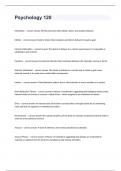Chapter 7- Communication
Organizational communication
Organizational communication within organizations is:
• Essential in selection and training of employees
• Organization communication is not neutral, but is an attempt from the management to
change the attitudes and behaviour of the employees to make them act towards the
company’s objectives.
• Most effective manner of communication depends on the communication goal.
• The bigger the change that needs to be communicated, the higher the degree of
involvement that is needed from the employees for the change to happen successfully and
thus the more intense the communication.
• Quirke’s communication escalator:
Interpersonal communication
Interpersonal communication= The transfer of information and meaning between at least two
people. Often corresponds to social imperatives (things normal in communication in a community).
Why communication is so hard
• Perceptual filters= Whether you are paying attention, whether you have the same
assumptions as the speaker etc.
, • Context= Success of communication also depends on the context. The receiver needs to take
the context into consideration to find out whether ‘great’ is actually meant to be decoded as
positive or sarcastic.
• Noise= Anything that may disturb communication. Not hearing someone well for example.
Other things affecting whether communication becomes a success:
• Power differences (high power distance affects communication)
• Gender differences (women communicate differently)
• Physical surroundings (round table positively affects communication)
• Language
• Cultural differences (you may say something inappropriate of the other’s culture)
Media richness
• Media richness theory= Different
media differ in terms of their richness,
such as:
- Speed of feedback
- Personal focus
- Whether you can use natural
language
- Feedback cues
• Complexity of information depends
on:
- Complexity
- Ambiguity
The richer communication media are, the more effective they are for communicating more
complex and ambiguous topics.
Verbal VS Non-verbal Communication
Verbal communication
• Verbal communication= The written or spoken conveying of a message. More conscious.
• You achieve what you want by using questioning techniques:
, • Conversation control signals/backchannel signals= Can help you find out what the receiver
thinks of your language and whether they understood you.
Non-verbal communication
• Non-verbal= Process of coding meaning through behaviours such as facial expressions,
posture, gestures, use of physical space, para-language (pitch, volume, intonation) and
social distance.
• It is all about the context of these things and what non-verbal communication are combined
(clusters).
• Power tells is other form
Power tells= Non-verbal signals that indicate to others how important someone (wants us
to think)/ thinks he is.
Trump tries to give a very powerful handshake to show he is the more dominant person.
Cultural differences
• High-context culture= Social and non-verbal cues are key to communication
Relationship first, based on trust, multiple intersections with others, long-term relationships
• Low-context culture= Verbal, brief and direct communication is most important
Business first, based on legal contracts, separation in time, space, relations, more short-term
connections.
Communication climate
Communication climate= The atmosphere in an organization in which ideas and information are
exchanged.
Different kinds of intelligence
Intelligence= Capacity to acquire and apply knowledge as measured by intelligence tests.
• Emotional intelligence= The ability to identify, integrate, understand and reflectively
manage one’s own and other people’s feelings.
• Social intelligence= The ability to understand other people’s thoughts and feelings and to
manage our relationships accordingly.
This really affects communication as well of course.
, Impression management
• Impression management= The process through which we manipulate the image or
impression that others have of an event, person or ourselves, by regulating and controlling
information in social interaction. This can be non-verbal and verbal communication.
• We can affect this if we are aware of the signals we are sending and can then control them.
This can affect how people think of you.
• Impression management happens face-to-face but also through social media. You are
managing the impression the audience has of you.
• People have different ways to present themselves depending on the audience (colleagues,
friends, family):
- Front stage behaviour= Actions visible to the audience and part of the performance
- Back stage behaviour= Actions that people engage in when no audience is present.
Your own self-perception is also affected by impression management. When you use a certain
powerful posture, you do also think more powerful of yourself.
Chapter 19- Organizational change
Change
Based on change triggers, organizations may identify that organizational change is necessary. It is
important to then analyse the change that is necessary and how to implement this. They can then
find which change communication is needed to implement it.
Trigger → Need for change → Initiating change → Implementing change
Triggers of change= Disruptive influences that disrupt the current systems, procedures or rules
which are insufficient, inappropriate or ineffective.
• External trigger: Change is prompted by the external environment (political, social,
technological, economic etc.)
• Internal trigger: Change is prompted from the company itself, such as policy, management,
attitudes.
Types of organizational change
From small to radical change:











